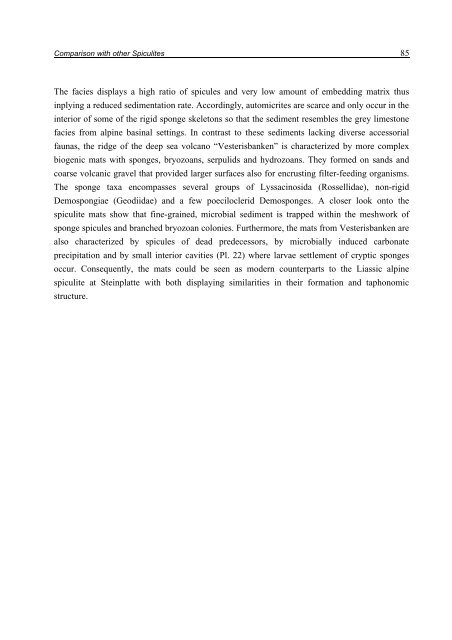Porifera-microbialites of the Lower Liassic (Northern Calcareous ...
Porifera-microbialites of the Lower Liassic (Northern Calcareous ...
Porifera-microbialites of the Lower Liassic (Northern Calcareous ...
Create successful ePaper yourself
Turn your PDF publications into a flip-book with our unique Google optimized e-Paper software.
Comparison with o<strong>the</strong>r Spiculites 85<br />
The facies displays a high ratio <strong>of</strong> spicules and very low amount <strong>of</strong> embedding matrix thus<br />
inplying a reduced sedimentation rate. Accordingly, automicrites are scarce and only occur in <strong>the</strong><br />
interior <strong>of</strong> some <strong>of</strong> <strong>the</strong> rigid sponge skeletons so that <strong>the</strong> sediment resembles <strong>the</strong> grey limestone<br />
facies from alpine basinal settings. In contrast to <strong>the</strong>se sediments lacking diverse accessorial<br />
faunas, <strong>the</strong> ridge <strong>of</strong> <strong>the</strong> deep sea volcano “Vesterisbanken” is characterized by more complex<br />
biogenic mats with sponges, bryozoans, serpulids and hydrozoans. They formed on sands and<br />
coarse volcanic gravel that provided larger surfaces also for encrusting filter-feeding organisms.<br />
The sponge taxa encompasses several groups <strong>of</strong> Lyssacinosida (Rossellidae), non-rigid<br />
Demospongiae (Geodiidae) and a few poeciloclerid Demosponges. A closer look onto <strong>the</strong><br />
spiculite mats show that fine-grained, microbial sediment is trapped within <strong>the</strong> meshwork <strong>of</strong><br />
sponge spicules and branched bryozoan colonies. Fur<strong>the</strong>rmore, <strong>the</strong> mats from Vesterisbanken are<br />
also characterized by spicules <strong>of</strong> dead predecessors, by microbially induced carbonate<br />
precipitation and by small interior cavities (Pl. 22) where larvae settlement <strong>of</strong> cryptic sponges<br />
occur. Consequently, <strong>the</strong> mats could be seen as modern counterparts to <strong>the</strong> <strong>Liassic</strong> alpine<br />
spiculite at Steinplatte with both displaying similarities in <strong>the</strong>ir formation and taphonomic<br />
structure.

















